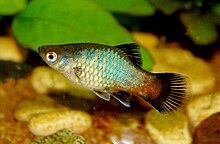User:Jaspergeli/Common platy
| Southern platyfish | |
|---|---|

| |
| Female ‘rainbow wagtail’ platy | |
| Scientific classification | |
| Domain: | Eukaryota |
| Kingdom: | Animalia |
| Phylum: | Chordata |
| Class: | Actinopterygii |
| Order: | Cyprinodontiformes |
| Family: | Poeciliidae |
| Genus: | Xiphophorus |
| Species: | X. maculatus
|
| Binomial name | |
| Xiphophorus maculatus (Günther, 1866)
| |
The southern platyfish, common platy, or moonfish (Xiphophorus maculatus) is a species of freshwater fish in family Poeciliidae of order Cyprinodontiformes. It is a small, brightly-colored, live-bearing freshwater fish of Mexico and Central America and popular in aquariums.
Etymology
[edit]It is commonly known simply as the "platy", from the fish’s original generic name, Platypoecilus. "Platy" means flat, a reference to the deep body and "poecilus" from the Greek word "poikilos", which means "with a lot of colors". "Platy" is the generic name for the species in the subgenus Platypoecilus but can also be a specific name for the southern platyfish to shorten its name.
Distribution
[edit]It is native to North and Central America: Ciudad Veracruz, Mexico to northern Belize.
Habitat
[edit]Adults occur in warm springs, canals, and ditches with typically slow-moving water, silt bottoms and weedy banks. Also, inhabit creeks and swamps.
Description
[edit]Average lengths of the platies are 4 centimeters in males and 5 centimeters in females. Sexual dimorphism is slight, the male’s caudal fin being more pointed. The anal fin of the male fish has evolved into a gonopodium, a stick-shaped organ used for reproduction. The female southern platyfish's anal fin is fan-shaped. Wild forms are drab in coloration, lacking the distinctive dark lateral line common to many Xiphophorus species. It has 8 to 10 dorsal soft rays in total. The distinct line of black pigment mid ventrally on caudal peduncle is absent. The greatest body depth is about 1.6 times of the total length. Ventral rays of the caudal fin of males not elongated into a sword. Male gonopodium falling short of caudal fin base, without a membranous protuberance, the third ray with a strong hook.
Reproduction
[edit]They reach maturity in three to four months, and breed and reproduce readily. After of around 25 days of gestation, females will give birth to about 20–80 young at a time. Often young are eaten by the adults or other inhabitants of a communal aquarium but given plants and gravel to hide in, some will probably survive as these are hardy fish. Platy young are first seen at approx 8 mm long and will use cover to hide from predators and to look for food. Specialist fry food is available but any flake food, frozen, or live food that floats their way will be easily consumed. These require excellent water quality and care must be taken to avoid fry being sucked up into a gravel cleaning siphon. A thin membrane covering the siphon opening such a clean pair of tights will minimize this. A common statement in the trade is that it is harder to stop them breeding than to make them do so, with "surprise" fry appearing in community tanks regularly.
Diet
[edit]Platies feed on annelid worms, crustaceans, insects and plant matter.
Water conditions
[edit]Platies are easy to keep and well suited to a community aquarium. They prefer water with a 7.0–8.0 pH, a water hardness of 10.0–20.0 dGH, and a temperature range of 20–25 °C (68–77 °F).
Platy varieties
[edit]Breeders have developed a multitude of color varieties which are common aquarium fish for hobbyists.
- Swordless - This variety lacks a sword.
- Top sword - This variety has a sword in the top edge of the tail.
- Middle sword - This variety has a sword in the middle of the tail.
- Bottom sword - This variety has a sword in the bottom edge of the tail.
- Double sword (top & middle) - This variety has a sword in the top edge and middle of the tail.
- Triple sword (top, middle, & bottom) - This variety has a sword in the top edge, middle, and bottom of the tail.
- Double sword (middle & bottom) - This variety has a sword in the middle and bottom edge of the tail.
- High fin - The dorsal fin is longer than normal.
- Plume tail - The caudal fin has long rays in the middle.
Platy are found in many different colors. This is due to different layers of pigmentation on their skin. The layers (from furthest within to the outer layer) consists of red, yellow, black, iridescent (blue and green). Any combination of these layers can be present, leading to a wide variety of colors.
The shades of blue, cyan or turquoise, and green are iridescent, and can appear to change color with different lighting conditions or viewing angles; this is because these colors (unlike red, yellow, or black) are not due to pigments, but created through refraction within a layer of translucent guanine crystals.
In scientific research
[edit]Platies are used for genetic research.
"Swords"
[edit]The genus Xiphophorus consists of swordless platyfish and swordtails. Swordlessness is the primitive state.
Gallery
[edit]-
Fry
-
Pregnant female
-
Male platy with gonopodium
-
Female ‘Twin Bar’ or ‘Comet’ platy
-
‘Sunset’ platy
-
Wagtail platy
-
Blue platy
-
‘Hi-fin’ wagtail
-
Red ‘Salt and Pepper’ platy
-
Female black platy











